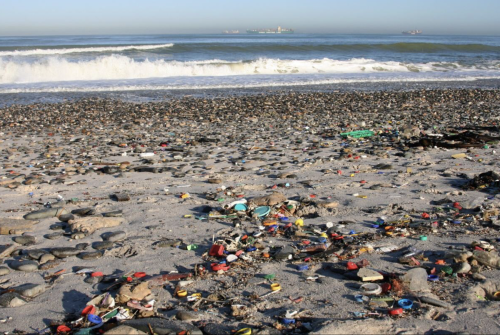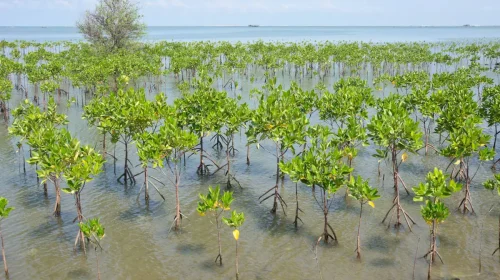Understanding Coastal Ecosystems

Photo Credit : Alamy/Seaphotoart
What is a Coastal Ecosystem?
Coastal ecosystems are unique habitats formed by plants and other organisms that can thrive at the borders between ocean and land. They are characterized by high levels of biodiversity and productivity. Our coasts contain many types of ecosystems, including mangroves, seagrass meadows, and coral reefs.

Photo Credit : ILLUSTRATION COURTESY NATIONAL GEOGRAPHIC MAGAZINE
Mangroves
Mangroves are coastal wetlands that thrive on low-energy shorelines in temperate and high-latitude areas. They are populated with salt-tolerant plants such as cordgrass and marsh elder that provide important nursery areas for many species of fish and shellfish.

Photo Credit : Pixabay
Seagrass
Seagrass is not the same as seaweed. Seaweed is a type of algae that does not have roots, stems, or leaves, and can grow in various depths of water. Seagrass, on the other hand, is a flowering plant that has roots, stems, and leaves, and can only grow in shallow water where sunlight can reach the seabed.
Seagrass meadows are underwater ecosystems that are found in warm, nutrient-rich waters, mainly in tropical and subtropical regions. Indonesia has the largest seagrass area in the world, covering about 30,000 square kilometers. Seagrass meadows are home to many marine species, such as fish, turtles, dugongs, and seahorses. They also provide important ecosystem services, such as filtering water, stabilizing sediments, preventing coastal erosion, and storing carbon.

Photo Credit : NOAA Photo Library
Coral Reefs
Coral reefs are highly productive and diverse ecosystems that provide protection and food for many marine species. Coral reefs also play a crucial role in protecting coastlines from erosion and damage from storms.

Photo Credit : Bruce Coleman
Coastal Ecosystems in Indonesia
Indonesia has a very long coastline, reaching 54,716 km. With a total of 17,504 islands, Indonesia is the largest archipelago in the world.
Most of Indonesia’s population lives in coastal areas. About 64% of the total population is a coastal population. Human activities along Indonesia’s coastline are very diverse, ranging from fishing, agriculture, to industry. For example, many coastal communities make a living as fishermen. In addition, shrimp and milkfish ponds are also commonly found in coastal areas. Industries are also developing in coastal areas, such as seafood processing industries.
Problems Facing Coastal Ecosystems
Coastal ecosystems are currently facing numerous threats. These include global warming causing sea level rise, pesticides and nutrients used in agriculture ending up in coastal waters, factories and industrial plants discharging sewage and other runoff into the oceans, extreme natural events such as hurricanes, coastal storms, tsunamis, and landslides, longer-term risks of coastal erosion and sea level rise, coastal development, population growth, and overfishing.

Photo Credit : Maleen/Marine Photobank
Proposed Solutions for Coastal Ecosystems
Indonesia has a rich and diverse coastal ecosystem that provides many benefits for its people and the planet. However, this ecosystem is facing various threats such as pollution, climate change, overfishing, habitat destruction, and overexploitation of resources. To address these challenges, some possible solutions are:
-
- Conserving and Restoring Mangroves : Mangroves are important for protecting the shoreline from erosion, flooding, and storms, as well as storing carbon and supporting biodiversity. Indonesia has the largest area of mangroves in the world, but also the highest rate of mangrove loss. The government has set a target of rehabilitating 600,000 hectares of mangroves by 2024 (World Bank, 2022). Mangrove conservation and restoration can also create jobs and income for local communities.

Photo Credit : One Earth
-
- Reducing Marine Plastic Pollution : Indonesia is the second-largest contributor of marine plastic debris in the world, which harms marine life and human health. The government has committed to reduce marine plastic waste by 70% by 2025. To achieve this goal, some actions include improving waste management systems, promoting circular economy models, raising public awareness, and engaging stakeholders from various sectors.
- Promoting Sustainable Fisheries and Aquaculture : Indonesia has one of the largest and most productive fisheries in the world, but also faces the problem of overfishing and illegal fishing. Sustainable fisheries and aquaculture can ensure food security, livelihoods, and economic growth, while preserving the health of the marine ecosystem. Some measures include strengthening law enforcement, improving data collection and monitoring, implementing ecosystem-based management, and supporting small-scale fishers and aquaculture farmers.

Photo Credit : Kompasiana

